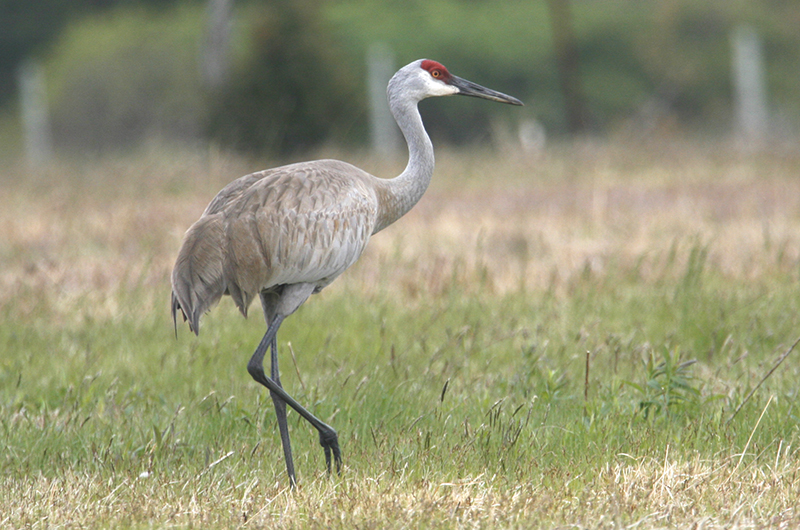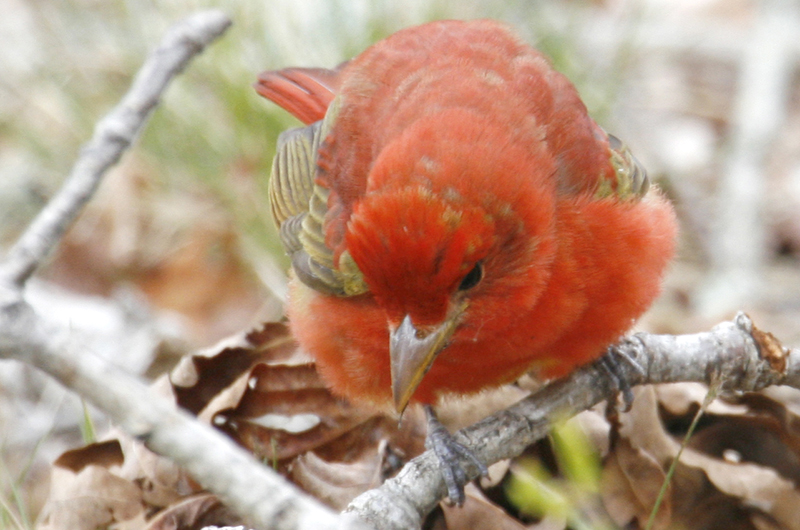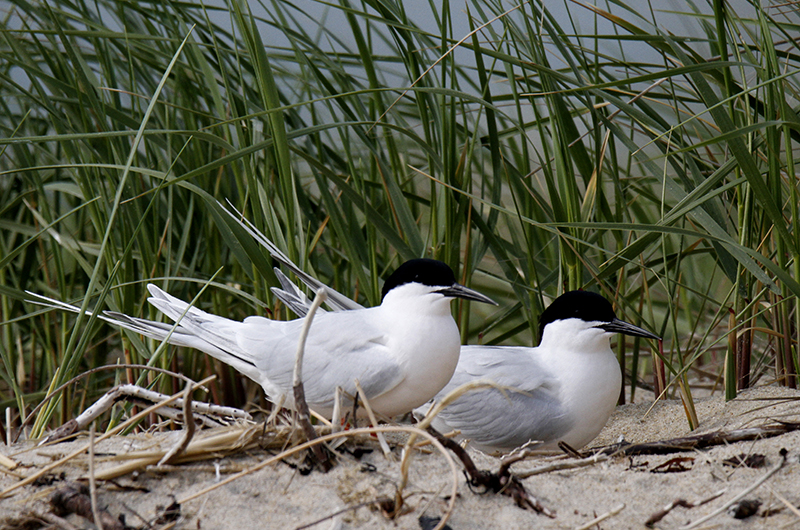This year’s northward migration is peaking now, but it continues to be about the return of our nesting birds rather than migrants moving through as they head to their more distant nesting grounds. The latter are what really excites birders, and a few of them are reported in this column.
I have been waiting to write this sentence for a while: Matt Pelikan spotted a brown pelican as it was heading west along Norton Point Beach on May 10. This is the second brown pelican of the season, which he saw under “brutal wind” conditions.
One sandhill crane is thrilling, but having two on the Island at one time is quite unexpected (they nest in western Massachusetts). Both birds showed up on May 9, and so far I have no reports of them the next day. Chris Doe spotted the first one at Nat’s Farm in the early afternoon. Mariah BenDavid spotted the bird later in the field adjacent to the WT school. At about the same time, another one showed up in Emma Green-Beach’s yard near the high school.
Summer tanagers breed mostly in the south. But still they come, shooting past their usual destinations of southern Pennsylvania and points south. There were three seen at feeders on May 9, by Donna Kelly, Polly Bassett and Heidi Feldman.
A blue grosbeak (another southern species) was spotted by Ken Magnuson, Bob Shriber and Lanny McDowell at the Edgartown Golf Club on May 8.
White-crowned sparrows breed well to our north and well to our west. But they pass through on their migrations and one was observed by Holly Mercier at her feeder on May 5.
Finally, Phil Edmundson spotted a pair of blue-winged teal on a small pond near Moshup Trail on May 5.
Bird Sightings
Of course there are many of our breeding species arriving as well. Some have been here for a while, others are new sightings.
Rose-breasted grosbeaks are now as abundant as they get at feeders. Males — you see one and you know they are named appropriately — were seen by Alan Slater on May 5, while on May 6 they were observed by Lisa Maxfield, Elizabeth Luce and Laurie Meyst. They were all over the place on May 9, spotted by Morgan Hodgson, Cira Goldstein, Tracy Morgan, and both a male and a female by Marie and Dan Larsen. On May 10, both Beth Biros and Susan Catling observed them.
Baltimore orioles are now all over the place and frequenting half oranges put out for them. Orchard orioles are another story. Small numbers of them breed here in select locations, but now there are lots of them around. On May 5, they were seen by Graham Houghton, Francesca Zeta (two places), and Sarah Carr. The next day, Daisy Kimberly, Kathleen Kinsman and Susan Kirchmeier Goldstein saw them. Pat Ingalls had both a male and a female on May 7. I heard and saw a male singing on May 9, and Richard Colter saw a pair on May 10.
Male scarlet tanagers have also arrived — cousins of the summer tanagers mentioned earlier — with their jet black wings and bright red bodies that make cardinals seem dull in comparison. They have been seen by Mary Beth Baptiste on May 8, and on May 10 by both Sarah Carr and Phyllis Kugler.
Warblers are also becoming more common. Eight species have been reported by multiple observers from multiple locations: ovenbird, black-and-white warbler, northern parula, common yellowthroat, American redstart, pine warbler, prairie warbler, and yellow warbler. The observers include Phil Edmundson, Fransesca Zeta, Bob Shriber, Bridget Dunnegan, Sea Williams, Luanne Johnson, Lanny McDowell and Cynthia Bloomquist. The only non-breeding warbler was a lingering winter resident yellow-rumped warbler spotted by Bob Shriber.
Larry Hepler spotted two brown thrashers in his yard on May 9.
Two species that are among the most amazing songsters are the wood and hermit thrushes. Both species can sing two notes at the same time. A wood thrush was spotted by Greg Pattison on May 7 and a hermit thrush was spotted by Luanne Johnson on May 10.
Two first of the year sightings of species that are known for their nocturnal singing (chanting) are chuck-wills-widow and whip-poor-will. Both were heard by Norma Costain on Chappaquiddick on May 7. Another species not often seen in the daytime is the American woodcock. Phil Edmundson observed four of them (likely a family) along Joe Walker Road on May 10.
On the waterbird front, terns have finally arrived. The black skimmers have returned to Little Beach as of May 6, when John Nelson spotted six of them. Since then, they have been spotted there by Luanne Johnson and Jeff Bernier. Common terns were first seen on May 5 at the Big Bridge on State Beach by John Nelson, and subsequently by Carol Goldstein and Luanne Johnson. Least terns have been observed by Tony Lima as they flew by above the Oak Bluffs School, Luanne Johnson at Little Beach, Francesca Zeta at Norton Point, and, most amazingly, on May 5 Bob Shriber estimated a minimum of 1,500 leasties flying east to west off South Beach in Edgartown. Finally, Matt Pelikan spotted two roseate terns on Norton Point Beach on May 10.
After watching all those least terns on May 5, Bob Shriber added a dozen ruddy turnstones. Jeff Bernier saw two ruddy turnstones at Little beach on May 10.
Finally, fish crows are still around. Luanne spotted a late flock of the crows that commute daily to Cape Cod near the entrance to Lake Tashmoo on May 5, as did Olsen Houghton on May 9. Elsewhere on the island, Margaret Curtin spotted 5 fish crows in downtown Edgartown on May 4, and on May 9 I observed five of them in Ocean Park and two on Circuit Avenue near Mocha Mott’s. Your help is needed to confirm their nesting — appropriate evidence is seeing them carrying either plant materials (nest building) or food (to feed their nestlings).
Watching birds helps relieve the isolation of social distancing! Stay healthy and report your sightings to birds@mvgazette.com.
Robert Culbert is an ecological consultant with Nature Watch LLC living in Vineyard Haven.










Comments (1)
Comments
Comment policy »